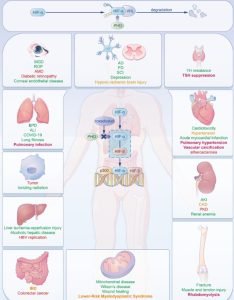
Potential effects on kidney diseases
Imagine a world where a single pill could potentially treat a host of diseases ranging from kidney complications to neurological disorders. That’s the hope researchers are pinning on a compound called roxadustat. When kidneys experience reduced blood flow, a condition known as ischemia, roxadustat steps in as a defensive agent. This drug can fight off inflammation, a common response to tissue damage, and also counteract a process called apoptosis. In simpler terms, apoptosis is like a self-destruct button that cells can activate. Additionally, it might help in preventing kidney injuries caused by various factors like inflammation and oxidative stress. Clinical trials involving over 8,000 patients have shown roxadustat’s efficacy in boosting hemoglobin levels in those with renal anemia.
Potential effects on cardiovascular diseases
For our cardiovascular system, which comprises the heart and blood vessels, roxadustat seems to be a potential guardian. These cells rely on energy, and under low-oxygen conditions (imagine trying to breathe at high altitudes), roxadustat helps them produce this energy efficiently. Moreover, if the heart suffers damage from sudden blockages, a situation termed ischemia-reperfusion injury, this drug can minimize that damage.

Potential effects on respiratory diseases
Our lungs, the primary organs for breathing, might find an ally in roxadustat. For babies born prematurely, the drug can accelerate the maturation of their lungs by promoting alveolarization. Think of alveoli as tiny air balloons in our lungs where the actual oxygen-carbon dioxide exchange takes place. If the lungs suffer injury from low oxygen levels or elevated pressures, roxadustat offers a protective shield. With the global pandemic, there’s speculation about its role against COVID-19, but that’s still a chapter under research.
Potential effects on neurological diseases
When it comes to the intricate network of our brain and nerves, roxadustat showcases potential protective properties. For debilitating diseases like Alzheimer’s and Parkinson’s, this drug might offer relief. Alzheimer’s, for instance, involves the accumulation of specific proteins in the brain, leading to memory loss. Roxadustat might play a role in handling this accumulation. However, in scenarios of brain injuries resulting from low oxygen levels, the drug’s role isn’t entirely clear, emphasizing the need for more research. Moreover, it could help in traumatic conditions like spinal cord injuries and even mood disorders like depression.
Potential effects on ophthalmic diseases
For individuals afflicted by dry eye disease, often linked to problems with the Meibomian gland, this drug presents a promising prospect as a novel treatment. Furthermore, when the retina, the innermost layer of the eye responsible for detecting light, encounters threats, roxadustat may offer protective effects. However, in conditions like diabetic retinopathy, where damage to the blood vessels in the retina is caused by diabetes, ongoing research is still exploring the full scope of the drug’s implications.
Potential effects on hereditary metabolic diseases
Inherited metabolic disorders, which are diseases resulting from genetic issues in our metabolism, could find an ally in roxadustat. It assists cells in producing energy efficiently and counteracts the adverse effects of specific genetic disorders, such as Wilson’s disease, characterized by the accumulation of copper in the body. By reducing hepatic copper levels and enhancing hepatic metabolism, roxadustat contributes to the management of the symptoms and complications associated with Wilson’s disease.
Potential effects on cancer
Cancer, characterized by uncontrolled cell growth, presents a complex relationship with roxadustat. While the drug might help create a more favorable environment around tumors, possibly restricting their growth, its precise role in either the initiation or spread of cancer isn’t black and white. Some studies have suggested that roxadustat could have a positive impact on tumor microenvironments, potentially normalizing them and improving tumor blood supply, which could hinder tumor progression and metastasis. Additionally, roxadustat has been shown to directly regulate certain immune cells, transforming them into a more phagocytic phenotype, which may enhance the body’s ability to defend against tumors. However, it’s important to note that the effects of roxadustat on cancer initiation and progression are still under investigation. The relationship between the drug and cancer risk factors is complex and requires further research to fully understand.
Potential effects on other diseases
Roxadustat appears to be a versatile agent, showcasing potential benefits across a range of health areas, from liver health to aiding in bone healing after fractures. In the context of liver health, the drug has shown promise in protecting against alcoholic hepatic disease by suppressing inflammation and reducing oxidative stress in the liver.
When it comes to bone health, roxadustat has displayed multifaceted effects. It not only promotes mature osteoclast bone resorption but also supports new bone formation following fractures. This dual action suggests that roxadustat may play a crucial role in bone remodeling and repair. Additionally, the drug has been found to enhance the proliferation and migration of bone marrow stem cells (BMSCs), facilitating their recruitment to fracture sites and contributing to the bone healing process.
Conclusion
To wrap it up, roxadustat is a drug with extensive potential across various medical fields, especially in kidney health. But like any medication, understanding its full spectrum of effects, both beneficial and adverse, is paramount. This includes determining the ideal dosage, duration of treatment, and identifying which patients would benefit most from its use.
The translation of the preceding English text in Chinese:
潜在的肾脏疾病影响
想象一下,有一颗药丸可能会治疗一系列从肾脏问题到神经系统疾病的疾病。这正是研究人员寄希望于一种叫做罗克度司他的化合物的地方。罗克度司他主要以其对肾性贫血的积极影响而闻名,这是肾脏疾病患者常见的并发症。当肾脏经历减少的血流时,一种称为缺血的情况,罗克度司他就会作为一种防御性药物介入。这种药物可以对抗炎症,这是对组织损伤的常见反应,并且可以抵消一种被称为凋亡的过程。简单来说,凋亡就像是细胞可以激活的自毁按钮。然而,对于慢性肾脏疾病,这是一种肾脏长期不正常功能的情况,使用罗克度司他的长期影响尚未完全解码。此外,它可能有助于预防由炎症和氧化应激等各种因素引起的肾脏损伤。肾性贫血是一种源于慢性肾脏疾病的疾病,肾脏无法产生足够的促红细胞生成素,导致红细胞减少。罗克度司他通过刺激红细胞生成的过程,即促红细胞生成,使其成为治疗这种疾病的佼佼者。涉及超过8,000名患者的临床试验显示,罗克度司他在提高肾性贫血患者的血红蛋白水平方面表现出了有效性。
潜在的心血管疾病影响
对于我们的心血管系统,包括心脏和血管,罗克度司他似乎是一个潜在的守护者。这些细胞依赖于能量,并且在低氧条件下(想象一下在高海拔地区呼吸),罗克度司他可以帮助它们高效地产生能量。此外,如果心脏因突然的血管阻塞而受损,一种被称为缺血再灌注损伤的情况,这种药物可以最小化损伤。
呼吸系统疾病的潜在影响
我们的肺是呼吸的主要器官,罗克度司他可能是一个盟友。对于早产儿,该药物可以通过促进肺的成熟来加速他们的肺部发育。想象一下肺泡是我们肺部的微小气球,那里进行着氧气和二氧化碳的交换。如果肺部因低氧水平或升高的压力而受损,罗克度司他可以提供保护。随着全球大流行病的爆发,有关其在对抗COVID-19中的作用的猜测,但这仍然是研究的一部分。
神经系统疾病的潜在影响
当涉及到我们复杂的大脑和神经网络时,罗克度司他展现出潜在的保护特性。对于像阿尔茨海默病和帕金森病这样影响记忆和运动的疾病,这种药物可能会提供帮助。例如,阿尔茨海默病涉及到大脑中特定蛋白质的堆积,导致记忆丧失。罗克度司他可能在处理这种堆积方面发挥作用。然而,在由低氧水平引起的大脑损伤情况下,该药物的作用并不完全清楚,强调了需要更多的研究。此外,它可能有助于创伤性情况,如脊髓损伤,甚至情绪障碍,如抑郁症。
遗传代谢性疾病的潜在影响
遗传代谢性疾病,即由于代谢过程中的遗传问题而导致的疾病,可能会在罗
克度司他中找到一个盟友。它帮助细胞高效地产生能量,并对特定遗传性疾病的不利影响进行抵消,比如威尔逊氏病,该病以体内铜的堆积为特征。通过降低肝脏中的铜含量并改善肝脏代谢,罗克度司他有助于管理与威尔逊氏病相关的症状和并发症。
对癌症的潜在影响
癌症以细胞不受控制的生长为特征,与罗克度司他存在复杂的关系。尽管这种药物可能有助于在肿瘤周围创造一个更有利的环境,可能限制其生长,但其在癌症的发病或扩散中的确切作用并不是非黑即白的。一些研究表明,罗克度司他可能对肿瘤微环境产生积极影响,可能使其正常化,并改善肿瘤的血液供应,从而可能阻碍肿瘤的发展和转移。此外,已经证明罗克度司他可以直接调节某些免疫细胞,使它们转化为更具吞噬活性的表型,这可能增强机体对肿瘤的防御能力。然而,值得注意的是,罗克度司他对癌症的发病和进展的影响仍在研究中。该药物与癌症风险因素之间的关系复杂,需要进一步的研究来充分理解。
对其他疾病的潜在影响
罗克度司他似乎是一种多功能药物,展示了在各种健康领域的潜在益处,从肝脏健康到骨折后的骨愈合。在肝脏健康方面,该药物已显示出在抑制肝脏中的炎症和减少氧化应激方面保护酒精性肝病方面的潜力。
当涉及骨骼健康时,罗克度司他展现出多面效应。它不仅促进成熟的破骨细胞骨吸收,还支持骨折后新骨的形成。这种双重作用表明罗克度司他在骨骼重塑和修复中可能起着关键作用。此外,已发现该药物可以增强骨髓干细胞(BMSCs)的增殖和迁移,促进它们到达骨折部位,并促进骨骼愈合过程。
结论
总之,罗克度司他是一种具有广泛潜力的药物,尤其在肾脏健康方面。但像任何药物一样,了解其完整的效果谱,包括有益和不利的效果,至关重要。这包括确定理想的剂量、治疗持续时间,并确定哪些患者最能从其使用中受益。
Reference: Li Q-Y, Xiong Q-W, Yao X, Liu F, Tang X, Fu H, Tong T, Mao J, Peng W-X. Roxadustat: Do we know all the answers?. Biomol Biomed [Internet]. 2023May1 [cited 2023Oct.18];23(3):354–363. Available from: https://www.bjbms.org/ojs/index.php/bjbms/article/view/8437
Editor: Ermina Vukalic
Leave a Reply